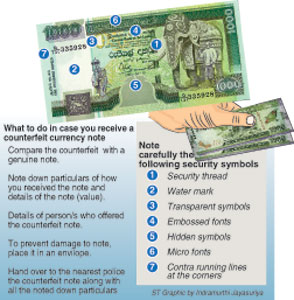Seven persons, including two women, were arrested last week with fake one thousand rupee notes in their possession. The arrests took place in Thanthrimalai, where these persons had passed off counterfeit notes to buy goods to the value of Rs.73,000. The arrested persons were identified as residents from Kottawa, Rajagiriya, Eppawala and Saliyapura. According to the Thanthrimalai Police, the counterfeit notes were printed in Mathiyagoda.
Another two persons were arrested recently in Kahawatte, Pelmadulla, when they attempted to pass off a fake one thousand rupee note at a communications centre. Police found Rs. 48,000 in fake notes on the pair. The notes had been printed at a house in Badulla, said the Kahawatte Police, who are investigating.
The Police are using more effective methods to crack down on counterfeiters, and, thanks to greater public alertness, they have made a number of arrests in recent months, said a senior Central Bank official.
C. P. A. Karunatilake, who heads the Central Bank Currency Department, told the Sunday Times that counterfeit money has been surfacing increasingly over the past five years. The Central Bank runs counterfeit currency awareness programmes, which are well attended by members of the public. At least 35 such programmes were conducted last year.
The international ratio of counterfeit to genuine currency notes is one per one million. In Sri Lanka, the ratio used to be three fake notes per million genuine notes, but the rate has gone up to approximately five fakes per million, Mr. Karunatilake said.
One reason for the increase is that fake notes have been successfully passed for real in certain parts of the country, and this had emboldened counterfeiters. The Police have intensified surveillance and conduct regular raids.
“Genuine notes have security features and can be easily identified,” Mr. Karunatilake said. “The quickest way to tell a fake from a real note is the texture. Genuine notes are printed on 100 per cent cotton paper. Fakes are printed on pulp paper. Cotton paper is rougher than pulp paper.
“Most counterfeiters simply scan the original currency notes, but scanners do not capture micro lettering.
“Genuine notes have raised print that can be felt when you stroke the notes with your fingertips. Also, a genuine note with folds or crush marks can be straightened out with a smoothing iron. Fake notes don’t respond the same way.
“When you hold a true currency note up to the light, you will see watermarks with images such as birds. True notes also have security threads. These see-through features are found only on genuine notes.”
There are also subtle features known only to Central Bank officers, but not to commercial banks and the general public, while still other, even more subtle, features are known only to the printer. “The Central Bank of Sri Lanka is working closely with the Criminal Investigation Department to trace forged notes and crack down on counterfeiters.” Mr. Karunatilake said.
“There have been instances of fake notes coming into the Central Bank from commercial banks. If commercial banks have no system for checking every banknote they receive, they will only be encouraging the counterfeiters. If there is no such detection mechanism, fake notes can come into banks and go back into circulation from commercial bank counters or from ATMs [automotive teller machines].
“A counterfeiter can easily palm off a forged note buried in a bundle of genuine notes. The note-counting machine you see in banks does not detect fakes. Fake notes have been slipped into the Central Bank through bundles of notes submitted by commercial banks.” |


